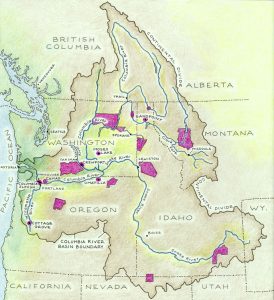Columbia Communities

Camas, Washington
Columbia Basin Native Fishery
Columbia Slough, Oregon
Cottage Grove, Oregon
Moses Lake, Washington
Sandpoint, Idaho
Umatilla, Oregon
Crewport, Washington
Center for Columbia River History staff, contracted consultants, graduate and undergraduate students from Portland State University and Washington State University (Pullman and Vancouver campuses) worked with community institutions, residents, and volunteers to create and exchange the following community internet exhibits. Funded by a US Department of Education grant through Portland State University (HEA-II-B, Library Research and Demonstration Project), the Columbia Communities project explores the histories of eight different Columbia River Basin communities since the building of major dams on the Columbia and its tributaries beginning in the 1930s. Each of the eight Web sites features extensive primary sources, including maps, oral history interviews, documents, newspapers, and photographs. Bibliographies contribute additional information about each community, and audio excerpts and curriculum questions enrich the exhibit tour.
Essay: Columbia Communities Themes

Camas, Washington
Since 1883 the Camas paper mill has had six different owners, but it still provides jobs for over a thousand men and women. This exhibit outlines how the mill shaped the history of this community perched on the Columbia River between Vancouver, Washington, and the Bonneville Dam. Other themes explored include labor relations, environmental issues, and the post-1970s transformation of Camas by high-tech industries, annexations, and urban commuters.

Columbia Basin Native Fishery
Featuring legal documents and treaties, this site explores the traditional and contemporary native fisheries of the Columbia Basin, including those in Canada. Find out about the treaty right to fish, the effect of dams on the native fisheries, traditional fishing implements, and significant fishing sites Kettle Falls and Celilo Falls.

Columbia Slough, Oregon
This site explores the significance of an urban waterway in the Portland Metropolitan area. The 18-mile long Columbia Slough, once part of the Columbia River floodplain, has been re-shaped over the past 100 years into a slow-moving drainage canal. The site provides an extensive documents archive, aerial photos, maps, oral histories, and images highlighting the social and scientific problems faced by people living near the Slough since the mid-nineteenth century.

Cottage Grove, Oregon
This site explores the history of a mid-sized logging community in the southern Willamette Valley. Annual floods on the Willamette River and its tributaries often inundated downtown and made transportation difficult. Army Corps of Engineers plans in the 1940s for a flood control system in the valley changed the river environment and dismantled some of the small nearby communities.

Moses Lake, Washington
Adapted from the original exhibit produced by the Adam East Museum in Moses Lake, this site explores the construction of Grand Coulee Dam that created arid region that settlers had struggled to farm since the early twentieth century and brought new people to the area.

Sandpoint, Idaho
Originally a traveling exhibit developed by the Bonner County Historical Society, this site asks how the building of Albeni Falls dam near Lake Pend Oreille changed the timber and agricultural community of Sandpoint. Explore the history of Farragut Naval Training Station, anti-racism activism, and Kokanee Trout in this North Idaho community.

Umatilla, Oregon
Umatilla has been shaped by war and dam-building. The Umatilla Ordnance Depot (1941) brought jobs to northeastern Oregon, and McNary Dam (1953) helped the town grow. Seventy miles downstream, John Day Dam, completed in 1968, necessitated the removal of half the lower town. John Day Dam also made water available to farmers, contributing to the rise of corporate farms and contemporary conflicts over river management.

Crewport, Washington
Students and faculty of the Partnership for Rural Improvement and Chicana/o Studies Program at Yakima Valley Community College interviewed current and former residents of the Crewport migrant labor camp, who narrate the history of this Yakima Valley community. They describe family life, work, and the persistence of Crewport, which was established in 1941 by the Farm Security Administration to house farm laborers recruited first from the drought-stricken Plains States and then from Texas and Mexico to work area fields.